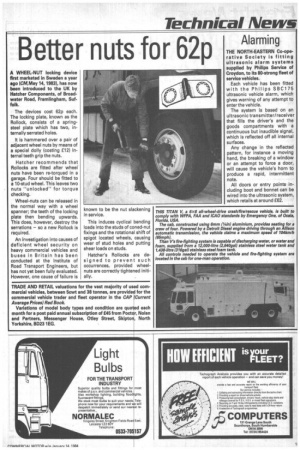Better nuts for 62p
Page 15

If you've noticed an error in this article please click here to report it so we can fix it.
A WHEEL-NUT locking device first marketed in Sweden a year ago (CM,May 14, 1983), has now been introduced to the UK by Hatcher Components, of Broadwater Road, Framlingham, Suffolk.
The devices cost 62p each. The locking plate, known as the Rollock, consists of a springsteel plate which has two, internally serrated holes.
It is hammered over a pair of adjacent wheel nuts by means of a special dolly (costing £12) Internal teeth grip the nuts.
Hatcher recommends that Rollocks are fitted after wheel nuts have been re-torqued in a garage. Four should be fitted to a 10-stud wheel. This leaves two nuts "unlocked" for torque checking.
Wheel-nuts can be released in the normal way with a wheel spanner; the teeth of the locking plate then bending upwards. This does, however, destroy the serrations — so a new RoIlock is required.
An investigation into causes of deficient wheel security on heavy commercial vehicles and buses in Britain has been conducted at the Institute of Road Transport Engineers, but has not yet been fully evaluated. However, one cause of failure is known to be the nut slackening in service.
This induces cyclical bending loads into the studs of coned-nut fixings and the rotational shift of spigot located wheels, causing wear of stud holes and putting shear loads on studs.
Hatcher's RoHocks are designed to prevent such occurrences, provided wheelnuts are correctly tightened initially.








































































